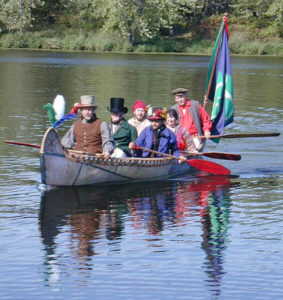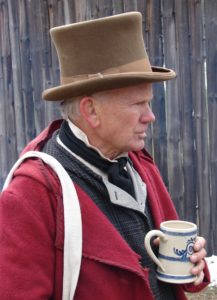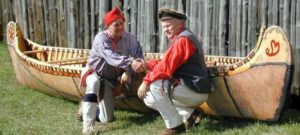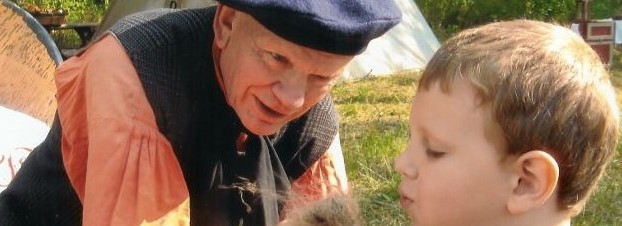In early 2009, veteran La Compagnie member Tom Brennan was confronting cancer. Thelma B encouraged him to keep at his different writing projects to help keep his mind off his health. Reminiscing about his “personal adventure of interpretation” turned out to be a productive distraction that spring. Here is part 2.

Tom as gouvernail during first launch of our new rabeska “Amitie” on the Snake River, Fall Gathering 2003. Photo courtesy of Linda Bryan
Get out the map: First, we want to have a general idea of the “lay of the land.” Every event happens somewhere, and we need to prepare by reviewing information about the site. It may come in the form of something as simple as a site brochure or as complex as a training manual.
Knowing why we are at a particular place is the foundation of how we plan for a particular event. Of course, there will be those events where there is no guiding outline. At those times, I find it helpful to discuss what we are going to portray with the rest of the group.
Understanding the lay of the land also implies we understand ourselves as an individual in a different time. Some call this the development of a “persona” and may go into great detail. I think it best to have a basic idea of “who” I am, but only to inform my own thinking. Sharing that persona with the visitor is probably not helpful and may cut into the time we have to teach.
Always be a student: Learning for me involves watching and listening to others interpret. I learn from those who have been doing this for a long time. There is a danger here. Just because someone says something does not make it correct. So, our listening must be with a questing mind. When the visitor is not around, ask for clarification, further information. Then check that information with other sources.
A strange reality of history is that “bad information” always seems to stick in people’s memory. Make sure we have the correct information.

Spring Thaw 2008, a rare day that Tom wasn’t smiling. Photo courtesy of Ron Engh
Chase your own rabbits: We need to do our own research. Good interpretation is not acquired by waiting for someone to spoon feed us knowledge that we then pass on to others. I cannot let someone else do all the research for me and still keep my interpretation fresh and alive.
We need to start by reading general histories of the fur trade, remembering, though, that some, such as Grace Lee Nute’s books, while basic to our understanding, are old and perhaps outdated. Some conclusions and assumptions of Nute and others have been reversed by later research.
After mastering a basic understanding of general fur trade history, turn to the primary documents from the time, the journals and letters of the traders. Journals such as those collected in Five Fur Traders of the Northwest (Gates, 1957) offer a flavor that history books cannot match. For the sheer pleasure of deciphering phonic spelling, read Peter Pond’s “narratives” aloud.
Dig deeper into interesting areas and something new will always find its way into the memory bank. I am better able to journey with the visitor through history if I have already traveled down some of its paths myself.
Watch your time period: Understanding the larger time frame is necessary even as you focus on a specific time and place with a visitor. Preparing a simple time line for our own use can keep us from a major gaffe.
One interpreter, telling me that Oliver Faribault would of course have preferred to trade with the North West Company, made me wonder about everything else he said. I knew that Oliver was trading in the 1840s and that the North West Company had merged some 20 years before with the Hudson’s Bay Company.

Tom and Al Gustavson, ready to organize a “group carry” of the brand new rabeska down to the Snake River landing for her maiden voyage. Photo courtesy of Linda Bryan
Creating time lines is a good collective exercise; we should consult each other’s research and share findings.
We are not always correct: A touchy area is that of giving and receiving correction. We need both to give and receive correction on interpretation gently and in a spirit of friends on the same journey.
Correcting inaccurate statements generally should be done away from visitors. Being corrected needs to be accepted in a gentle way as well. We are all learners. Correction is not given from a superior position but from one traveler to another. Nor should we assume the other is putting us down to tell us that we are using the wrong name or date or are wearing something not quite right for our time period. Talking it through may even lead to discovering new ways of interpretation.
Next: After answering who, what and where, now what do we do?

